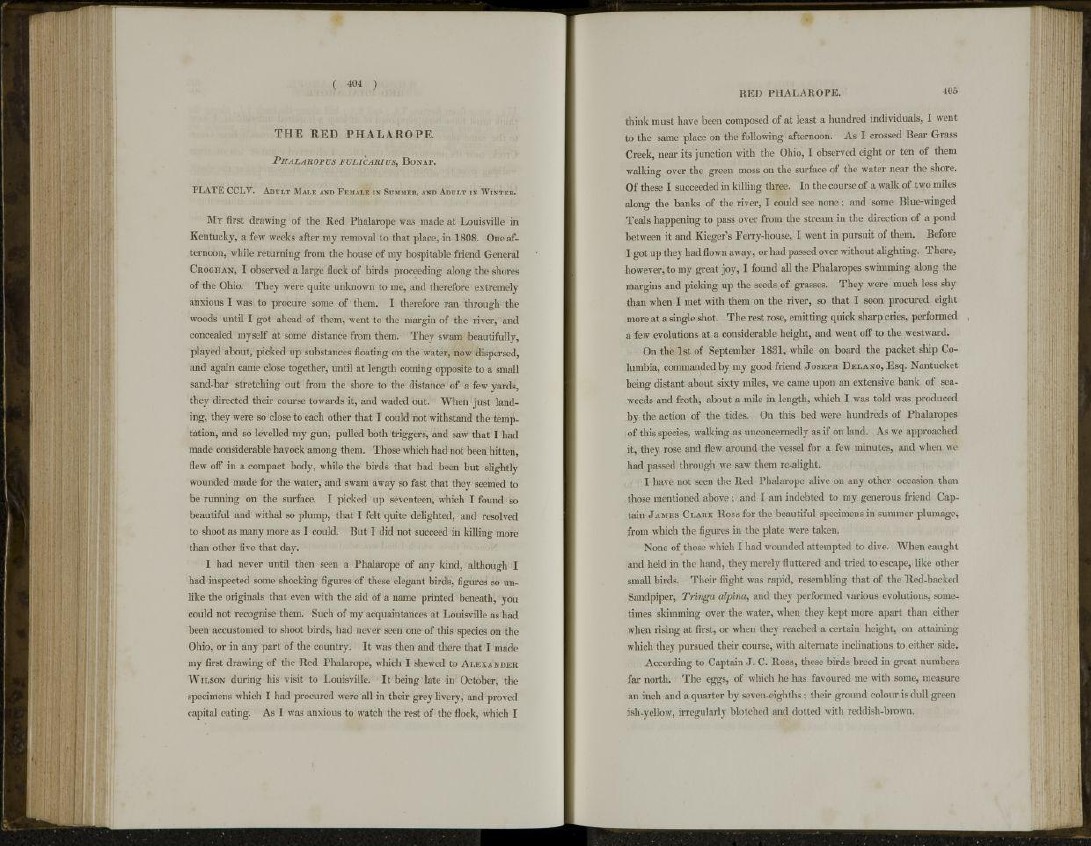
THE RED PHALAROPE.
PHALAROPUS FULICARJUS, BONAF.
PLATE CCLV. ADULT MALE AND FEMALE IN SUMMED, AND ADULT IN WINTER.
MY first drawing of the Red Phalarope was made at Louisville in
Kentucky, a few weeks after my removal to that place, in 1808. One afternoon,
while returning from the house of my hospitable friend General
CROGHAN, I observed a large flock of birds proceeding along the shores
of the Ohio. They were quite unknown to me, and therefore extremely
anxious I was to procure some of them. I therefore ran through the
woods until I got ahead of them, went to the margin of the river, and
concealed myself at some distance from them. They swam beautifully,
played about, picked up substances floating on the water, now dispersed,
and again came close together, until at length coming opposite to a small
sand-bar stretching out from the shore to the distance of a few yards,
they directed their course towards it, and waded out. When just landing,
they were so close to each other that I could not withstand the temptation,
and so levelled my gun, pulled both triggers, and saw that I had
made considerable havock among them. Those which had not been hitten,
flew off in a compact body, while the birds that had been but slightly
wounded made for the water, and swam away so fast that they seemed to
be running on the surface. I picked up seventeen, which I found so
beautiful and withal so plump, that I felt quite delighted, and resolved
to shoot as many more as I could. But I did not succeed in killing more
than other five that day.
I had never until then seen a Phalarope of any kind, although I
had inspected some shocking figures of these elegant birds, figures so unlike
the originals that even with the aid of a name printed beneath, you
could not recognise them. Such of my acquaintances at Louisville as had
been accustomed to shoot birds, had never seen one of this species on the
Ohio, or in any part of the country. It was then and there that I made
my first drawing of the Red Phalarope, which I shewed to A L E X A N D ER
WILSON during his visit to Louisville. It being late in October, the
specimens which I had procured were all in their grey livery, and proved
capital eating. As I was anxious to watch the rest of the flock, which I
RKI) PHALAROPE. 405
think must have been composed of at least a hundred individuals, I went
to the same place on the following afternoon. As I crossed Bear Grass
Creek, near its junction with the Ohio, I observed eight or ten of them
walking over the green moss on the surface of the water near the shore.
Of these I succeeded in killing three. In the course of a walk of two miles
along the banks of the river, I could see none; and some Blue-winged
Teals happening to pass over from the stream in the direction of a pond
between it and Kieger's Ferry-house, I went in pursuit of them. Before
I got up they had flown away, or had passed over without alighting. There,
however, to my great joy, I found all the Phalaropes swimming along the
margins and picking up the seeds of grasses. They were much less shy
than when I met with them on the river, so that I soon procured eight
more at a single shot. The rest rose, emitting quick sharp cries, performed ,
a few evolutions at a considerable height, and went off to the westward.
On the 1st of September 1831, while on board the packet ship Columbia,
commanded by my good friend JOSEPH DELANO, Esq. Nantucket
being distant about sixty miles, we came upon an extensive bank of seaweeds
and froth, about a mile in length, which I was told was produced
by the action of the tides. On this bed were hundreds of Phalaropes
of this species, walking as unconcernedly as if on land. As we approached
it, they rose and flew around the vessel for a few minutes, and when we
had passed through we saw them re-alight.
I have not seen the Red Phalarope alive on any other occasion than
those mentioned above; and I am indebted to my generous friend Captain
J A M E S CLARK ROSS for the beautiful specimens in summer plumage,
from which the figures in the plate were taken.
None of those which I had wounded attempted to dive. When caught
and held in the hand, they merely fluttered and tried to escape, like other
small birds. Their flight was rapid, resembling that of the Red-backed
Sandpiper, Tr'mga alpina, and they performed various evolutions, sometimes
skimming over the water, when they kept more apart than either
when rising at first, or when they reached a certain height, on attaining
which they pursued their course, with alternate inclinations to either side.
According to Captain J . C. Ross, these birds breed in great numbers
far north. The eggs, of which he has favoured me with some, measure
an inch and a quarter by seven-eighths; their ground colour is dull green
ish-yellow, irregularly blotched and dotted with reddish-brown.